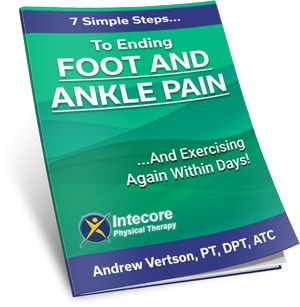
Ankle injuries are like uninvited guests at a party – they show up without warning and can really dampen your spirits. Whether you twisted your ankle on a morning jog or landed awkwardly, the immediate aftermath leaves you wondering: is it a sprain or a break? Knowing how to tell the difference between an ankle sprain and a broken ankle is crucial for taking the right steps towards recovery. So, grab a comfy seat (and maybe elevate that foot), as we take a look at common ankle injuries, helping you tell the difference and get back on your feet.
More Posts Like This By Intecore:
5 Ways To Alleviate Foot Pain When Walking
Do The Shoes You Wear For Running Actually Matter?
How Do I Cure My Ankle Pain?
Table of Contents
The Basics of Ankle Injuries
At the heart of our mobility lies our ankles, a complex system of bones, ligaments, and muscles, working in harmony to support our every move. When this harmony is disrupted by a sudden twist or impact, it leads to either a sprained ankle (where the ligaments, which connect bones to each other, are damaged) or a broken ankle (where one or more of the bones meet their breaking point).
Sprained Ankle vs Broken Ankle: Key Differences
Spotting the difference can be tricky since both injuries share common symptoms like pain, swelling, and a reluctance to bear weight. However, a closer look reveals subtle clues.
A sprain typically presents with localized pain around the ankle’s soft tissues and may allow for some degree of mobility, albeit painfully.
On the other hand, a break might radiate a sharper, more defined pain, especially when trying to move the affected area or touch the bone.
Symptoms and Diagnosis
Recognizing the Signs of a Sprained Ankle and a Broken Ankle
A sprained ankle might feel tender to the touch, accompanied by swelling and bruising. These signs indicate ligament damage, which varies in severity from mild stretches to complete tears.
Symptoms more indicative of an ankle broken include intense pain at a specific point, especially over a bone, significant swelling, and sometimes an apparent deformity or bone protruding the skin, signalling an emergency.
While these observations can guide you, only a medical professional can provide a conclusive diagnosis.
Tools like X-rays or MRI scans are often employed to visualize the extent of the injury, helping distinguish between a sprain and a fracture accurately.
Treatment Options and Recovery
Immediate First Aid Measures (RICE Method):
Regardless of the nature of the injury, the RICE method (Rest, Ice, Compression, Elevation) remains the golden rule for initial care. This approach helps manage swelling and pain in the critical hours post-injury.
Treatment for a Sprained Ankle:
Treatment varies with the sprain’s severity but generally includes rest, ice, compression, and elevation in the initial stages, followed by physical therapy to restore strength and mobility.
Treatment for a Broken Ankle:
A broken ankle may require immobilization with a cast or splint, and in severe cases, surgery to realign and fix the bones. Rehabilitation with physical therapy follows to regain strength and flexibility.
How to Speed Up Recovery
The journey to recovery hinges on diligently following your treatment plan. Additional measures like maintaining a healthy diet, rich in calcium and vitamin D, can foster bone health, while targeted exercises (under professional guidance) can rebuild strength and reduce the risk of future injuries.
When to See a Doctor
If you’re experiencing severe pain, cannot bear weight, or notice an obvious deformity, it’s crucial to seek medical attention promptly. Early intervention can mitigate the risk of complications and pave the way for a smoother recovery.
Preventing Future Ankle Injuries
Future injuries can be sidestepped with a few proactive steps, such as engaging in exercises to bolster ankle strength and flexibility, wearing appropriate footwear for activities, and warming up before exercise.
How Physical Therapy Helps
Physical therapy plays a pivotal role to full recovery, especially when dealing with ankle sprains or fractures. Here’s how physical therapy makes a difference:
Personalized Recovery Plans
Every injury is unique, and so is every recovery. Physical therapists assess your specific needs to create a tailored plan that addresses not only the injury itself but also the factors that led to it. This personalized approach ensures that therapy is effective and efficient, helping you return to your daily activities safely and confidently.
Pain Management Without Medication
Through various techniques such as manual therapy, ultrasound, and electrical stimulation, physical therapy helps manage pain effectively without relying solely on medication. These methods also stimulate the healing process, reducing inflammation and promoting tissue repair.
Restoring Strength and Flexibility
Injuries often lead to weakness and stiffness, making the affected area prone to re-injury. Physical therapists introduce exercises that gradually rebuild muscle strength and enhance flexibility. These exercises are designed to restore the ankle’s functionality to its fullest extent, ensuring a balanced and comprehensive recovery.
Accelerated Return to Activities
One of the primary goals of physical therapy is to facilitate a safe and timely return to normal activities, sports, or work. By closely monitoring progress and continuously adjusting the therapy plan, physical therapists help patients achieve their recovery goals faster and more effectively than would be possible with rest and home remedies alone.
Ready To Get Help With Physical Therapy?
If you’re dealing with the aftermath of an ankle injury and feeling uncertain about the best path to recovery, we’re here to help. Our team of expert physical therapists specializes in personalized recovery plans that address the injury and your overall well-being and fitness goals. Reach out today to schedule your first step towards a pain-free life by calling us here: 949-597-2103
Not quite ready to speak on the phone? We understand that taking the first step can be daunting. That’s why we offer our Free Ankle Pain Tips Guide. It’s packed with practical advice and simple tips to help you start managing your ankle pain right now, from the comfort of your home.
Download your free guide today and discover how you can begin your journey to recovery at your own pace. Let’s get you back on your feet, stronger and more confident than ever!

- 7 Ways to Get Rid of Tension Headaches Naturally - July 1, 2025
- Why Are My Feet Swollen? Common Causes Explained - June 2, 2025
- What Is Restless Leg Syndrome? Symptoms, Causes, and Relief Options - May 5, 2025













